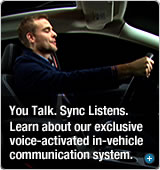We've been working with the U.S. Department of Transportation and other automakers to develop vehicle collision avoidance technologies that may help keep everyone on the road safer.

Vehicle-to-Vehicle Communication
We've been working with the Vehicle Safety Communications Two Consortium (VSC-2) to develop safety applications that allow vehicles to "talk" to each other and to the roadway. VSC-2 is a relationship that exists between the U.S. Department of Transportation and other automakers, including Ford Motor Company, General Motors, Toyota, DaimlerChrysler and Honda.
After successfully completing a project that demonstrated the feasibility of vehicle-to-vehicle and vehicle-to-road communication, VSC-2 will begin evaluating the following applications:
- Cooperative Intersection Collision Avoidance System: Violation Warning—As a car, truck, SUV or other vehicle approaches a traffic light, the vehicle would receive a message from the traffic light with the signal phase (red, yellow or green) and the amount of time until the signal changes. The vehicle would use this information, together with the vehicle position and speed, to decide if a warning or some other safety countermeasure (such as brake assist) is appropriate.
-
Vehicle-to-Vehicle Communications—VSC-2 members are working together to investigate the messages needed for vehicle-to-vehicle safety applications, including Electronic Emergency Brake Lights.
A vehicle with Electronic Emergency Brake Lights performing hard braking could send a message to vehicles behind it on the roadway, then those vehicles could warn their drivers, activate brake assist or even start automatic braking.
Building a Wireless Infrastructure for Vehicles
We're also participating in the Vehicle Infrastructure Integration National Coalition (VIINC). VIINC is working to deploy wireless technologies to support vehicle-to-vehicle and vehicle-to-road safety communications. In addition to vehicle safety applications, these wireless technologies could be used for mobility and commercial applications such as e-payment for parking, tolling and gasoline purchases.
Through VIINC, the U.S. Department of Transportation plans to fund the roadside infrastructure. Equipment manufacturers would provide the wireless on-board equipment. The U.S. Department of Transportation has proposed installing 250,000 dedicated short-range communications radio roadside transceivers nationwide by 2010.
ComCARE Alliance
We're a board member of the ComCARE Alliance, a nonprofit organization that encourages the establishment of wireless communication networks, infrastructure and technologies that enable emergency communications between the motoring public and public safety agencies.
The ComCARE Alliance is a coalition of the medical community; public health and safety officials; automobile, telematics and technology companies; safety groups and others.
RESPONSE Project
In Europe, we've been a leading contributor to the EU's "RESPONSE" project. RESPONSE was developed to ensure Advanced Driver-Assistance Systems are designed to be safe and consider the complex interaction of drivers and vehicle systems in multiple traffic situations.

